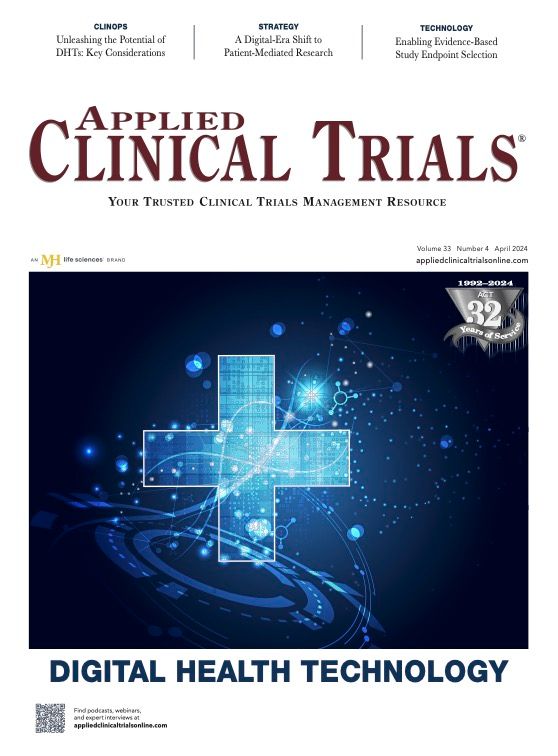The Future Fit of Wearables for Patient-Centric Clinical Trials
Harnessing these tools for successful integration and streamlining of processes.


In an era prioritizing personalized and patient-centric care, remote patient monitoring has become critical to achieving better healthcare outcomes. Among these technologies, wearables play a pivotal role in enabling healthcare providers (HCPs) to remotely monitor patients, gather real-time data, and make well-informed decisions to optimize patient care.
Wearable technology integration holds immense value in clinical trials. By incorporating these devices into clinical trial protocols, researchers can gather comprehensive data while minimizing participant burden. The technology allows for extended monitoring of patients’ health parameters, such as vital signs, medication adherence, and symptom progression, without the need for frequent in-person visits. However, choosing the right device can have a significant impact on study outcomes and conclusions.
To ensure precision and scientific validity in clinical trials, it is imperative to approach each study with a deliberate and endpoint-focused mindset. This involves carefully selecting monitoring devices or tools suitable for their intended purpose. It is not enough to monitor a specific aspect of a study with any device. Rather, it is essential to evaluate the scientific relevance of the chosen device, ensuring that the collected endpoint or variable holds significance in the study.
Due to Clario’s involvement in dozens of clinical trials involving wearables, we understand the importance of selecting the right one for the right purpose. This article will discuss the advantages of wearables in clinical trials, explore how to apply the technology effectively, and provide strategies for successfully integrating them from the perspective of study participants, trial sites, and drug developers. By gaining insights into these factors, researchers and HCPs can harness wearables to streamline trial processes and deliver high-quality care to patients.
Ensuring scientific rigor and compliance in device selection
Selecting the appropriate wearable technology for clinical trials is a crucial step that directly impacts the scientific integrity and validity of the study. Rather than beginning with a technology and trying to fit it into a study, it is imperative to begin by clearly defining the scientific purpose of the study. Wearables must align with the specific goals of the trial and uphold the highest standards of scientific rigor and validation. A key part of this process is determining the specific endpoint to be evaluated or proven. In turn, this informs how to identify the technology that most effectively supports or investigates that particular endpoint.
When choosing the appropriate devices, thorough market research is crucial, which requires meticulous evaluation of scientific literature and regulatory approvals pertaining to the available options. This empowers researchers to make informed decisions, ensuring that the chosen devices align with the highest standards of scientific validity and regulatory compliance. Consumer-grade devices may lack the same level of scientific rigor and validation, especially within the specific population of interest. It is essential to prioritize the selection of technology that has been developed for the intended use-case and has undergone thorough validation, including verification, analytical validation, and clinical validation (particularly within the targeted population). Additionally, the technology must allow developers full access to the patient data, and allow for integration into the clinical trial database, so it may be analyzed in conjunction with other trial data.
Selecting technologies that have the necessary regulatory approvals in the countries where the study will be conducted ensures compliance with local regulations and standards. This allows sponsors to use a device in studies without the need to apply for clinical trial exemptions and avoids potential delays.
In addition, the consideration of IT security is crucial. Log-in requirements, password reset features, data storage and retention, data back-up options, and 21 CFR Part 11 compliance, etc. all need to be investigated. Evaluating the data transfer process and ensuring alignment with the study requirements and with site capabilities are also vital. For instance, some countries have restrictions on the use of specific technologies for wireless data transmission. In those scenarios, alternative data transfer methods need to be explored to maintain compliance and data security.
Enhancing patient experience and privacy in device selection
When selecting wearable devices for clinical trials, prioritizing the patient experience is paramount. Considerations such as user-friendliness, comfort, and adherence to device usage are essential in ensuring successful patient engagement throughout the study. Devices that are cumbersome or difficult to use may lead to lower compliance and inaccurate and incomplete data collection.
Patient factors heavily influence device selection to ensure comfort and minimize intrusiveness. Our aim is to collect robust data for the study endpoint, while also maintaining a manageable data collection process that minimizes patient and site burden. Intuitive interfaces, clear instructions, and simplified setup processes are essential for removing barriers and promoting seamless adoption. By simplifying the process, participants can more readily engage in data collection. Factors such as the device’s comfort, non-intrusiveness, absence of frequent recharging requirements, and the ability to function without a constant Wi-Fi connection are important considerations in selecting a device/technology to implement in a clinical trial.
Patient privacy is a primary concern in clinical trials. Many consumer-grade devices prompt users to provide personal information, such as their name and birthday, upon opening the app. However, in clinical trials, collecting such information is unnecessary and often prohibited. Therefore, the app or interface must be tailored to meet the privacy requirements of clinical trials. This typically would include a customizable alphanumeric field that allows for the entry of a patient ID, which respects privacy regulations and eliminates the need for collecting unnecessary personal identifying information.
Wearables reshape clinical trials and patient monitoring
The integration of wearables in clinical trials has reshaped patient experience and data collection. Recent trials have showcased their remarkable impact in various healthcare domains, demonstrating the potential to transform medical research.
In one trial, a drug manufacturer aimed to characterize the potential heart rate effect of a new medication. Requiring frequent traditional clinic visits for vital sign measurements would not be feasible, but as an alternative, wearable monitors were employed to track heart rate continuously. By monitoring heart rates and comparing hourly data across different doses and on different days, researchers could accurately characterize the heart rate effect and develop an appropriate strategy for managing this. The remotely collected data provided valuable insights for the drug developer, and will be used in guiding clinicians and patients when initiating treatment in the future.
Before rebranding as Clario after joining ERT, Bioclinica collaborated with Vivalink to address a specific protocol safety endpoint, which required a remote/wearable patient monitoring solution. Based on the therapeutic indication and treatment, there was a need to implement continuous body temperature monitoring in the ambulatory setting. Use of Vivalink’s wearable temperature sensor allowed the study medical monitor to centrally review temperature data and identify any potential trends. The solution also included home blood pressure monitoring (via a separate device), integrated into the same display for central review by the monitor.
Importantly, collaboration between Vivalink, Clario and the sponsor team ensured that the solution would meet the goals of the study and remain user-friendly for the study participants. The sensor, discreetly placed on a subject’s underarm, consistently transmits axillary body temperature data to the cloud through a mobile application. With integration of the data into the Clario cardiac safety platform, the sponsor and medical monitors have real-time access through a web portal for comprehensive analysis and informed decision-making.
Incorporating wearables into clinical trials is not just a trend. Rather, it is a natural progression that is reshaping the landscape of medical research. By leveraging these advanced technologies, researchers can revolutionize patient experiences, gain critical data insights, and propel advancements in personalized patient care and treatment development. The regulatory environment is evolving as well, enabling increasing opportunities to incorporate this type of data into a drug development program and submission dossier. Wearables unlock a future where trials become more efficient, inclusive, and impactful, driving tangible improvements in patients’ lives worldwide.
Todd Rudo, MD, is Chief Medical Officer, Clario; Luc Dekie, PhD, is Director of Scientific Affairs, Cardiology, Clario
